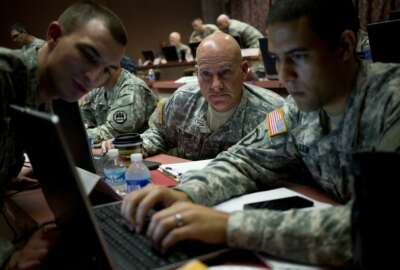
Impressed by DoD’s digital service, Army decides it needs one of its own
The Army says it’s becoming the first of the military services to launch a digital service “outpost” and wants a dedicated team of technology experts from...
First there was the U.S. Digital Service, then the Defense Digital Service. Now the Army says it’s becoming the first of the military services to launch a digital service “outpost” and wants a dedicated team of technology experts from outside the government to tackle its own problems.
Like USDS and DDS, the new Army Digital Service wants to hire employees on a term-limited basis —anywhere from three months to two years at a time — to tackle information technology challenges it hasn’t solved on its own. Officials offered few details about what projects the team will work on or how many staff members will be dedicated to the Army, but said the parent organization, the Defense Digital Service, has about two dozen employees and plans to hire about 20 more in the coming months.
“We have an almost unlimited target set of problems where we want some help,” Army Secretary Eric Fanning said at a New York kickoff event Friday afternoon. “I know the other military services are talking about doing the same thing because there’s so much potential in this model in an area where we have so much to do. What we can guarantee you is that you’ll be working on projects around an incredible mission, and you will have a significant impact, and you’ll have impact quickly and noticeably.”
The existing Defense-wide digital service has already worked on several fairly high-profile projects since Defense Secretary Ash Carter announced its standup a year ago, including an overhaul of the aging Defense Travel System military employees use to book airfare and hotels, speeding up the development of the next generation of GPS control systems, and the Hack the Pentagon challenge, the government’s first bug bounty.
“A good way to think of us is a SWAT team of nerds,” said Chris Lynch, DDS’ director. “We come from our own lives outside of government and work on problems of impact, and they’re people who don’t fit the mold of what the government has by itself. We have developers, designers, product managers, and what we call bureaucracy hackers. We want the best of tech to come out, do a tour of duty, work on something that matters, but then ideally go back to where you came from and tell people about it.”
And the DDS has already been deployed for a couple of Army-specific projects, including the recently-announced Hack the Army program officials launched to test the security of recruiting and personnel databases.
“It’s an offshoot of the Hack the Pentagon challenge, but they were only using it on static, public websites,” Fanning said. “We’re using the same process on systems that hold some pretty sensitive information, and it’s already been a pretty dramatic success. I’m not sure we’d even finished the launch before we were getting the first vulnerability reports.”
DDS has also been helping with a project to digitize much of the paper-based process incoming Army recruits have to deal with when they first enlist. Lynch said one particular team member, Daniel Hoag, a former Google engineer, decided he could pretty easily overhaul the current process, where recruiters print and mail large packets of documents to incoming recruits who then have to sign the paperwork and have it scanned into another system once they reach boot camp.
“We went out on a two-week discovery sprint just to see what was going on with the recruiting pipeline, and Dan was like, ‘Hey, actually I think we can take this all digital, I’m just going to stay here and work on this right now,’” Lynch said. “They’re pretty close to being able to see this actually happen, and that’s pretty cool. You can just show up and when you see something that’s not working the way it should be, you can apply your skills to fix it. I don’t know how to describe the feeling, but every time we do this, I get goosebumps.”
And Fanning sought to assure prospective future members of the Army’s nerd SWAT team that the notion of a digital service isn’t a passing fad destined to fade once a new administration takes over in January.
“The set of issues we’re targeting doesn’t change with the election,” he said. “It’s not really related to any particular administration. It’s related to what we’re seeing our adversaries doing, combined with the fact that we have old ways of doing business that need to change. This isn’t my initiative, this is something the Army needs, and it will survive the transition. It’s a little bit like saying we need oxygen.”
Return to the DoD Reporter’s Notebook
Copyright © 2024 Federal News Network. All rights reserved. This website is not intended for users located within the European Economic Area.
Jared Serbu is deputy editor of Federal News Network and reports on the Defense Department’s contracting, legislative, workforce and IT issues.
Follow @jserbuWFED





